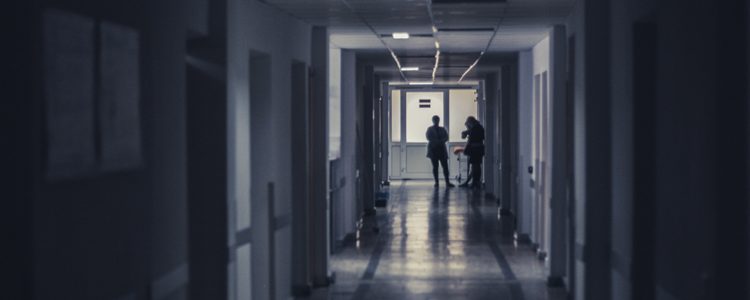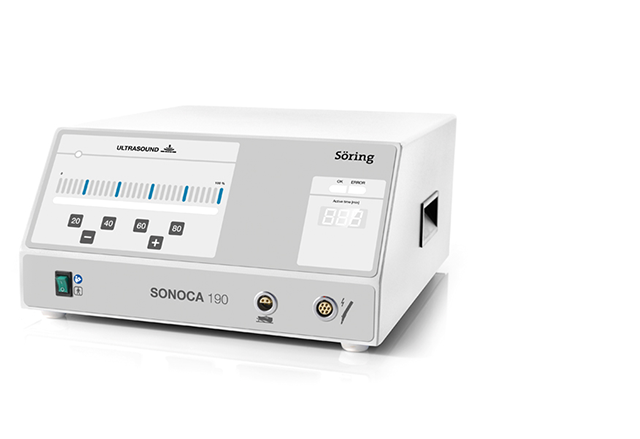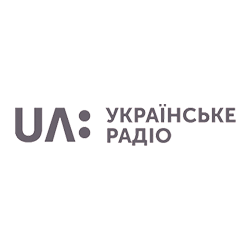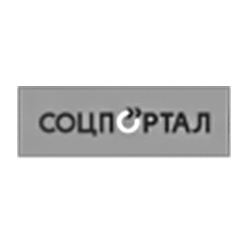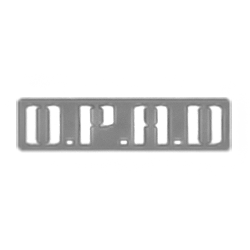The Institute of Traumatology and Orthopedics of the National Academy of Medical Sciences of Ukraine. It is rather noisy here, at their main entrance, as crispy winter air is disrupted by the sound of a chainsaw: a busy worker cuts off the fragment of the front door. Annoyed visitors are passing in and out in flashes of bright sparks. We can see young people and a man with a piercing look whose posture hints of his military career, and ordinary men and women of all ages – these are the patients who gets treatment at the Institute, and their families. Two women come out of the building: one of them has her right arm in a gypsum cast while another one wears a bandage on her left one. They try to support each other – looks like they have just merged into a single full functioning body. The women ask for a lighter, get their cigarettes done and step aside for a smoke.

Well, it’s about the Institute of Traumatology and Orthopedics. It is from here that we received the call for help. The Bone Infectious Surgery Unit is in an urgent need of equipment that would enable doctors to effectively treat their patients literally saving their lives.
In the Unit’s hallways, we face the same peculiar atmosphere characteristic of profile medical institutes. It is rather easy to differentiate people who came here for their first visit, from those who have been accustomed here: they look different thanks to the expression of weariness and lack of hope. Those who used to visit the Institute before, look rather reserves, still their faces still highlighted by hope. The furnishing here is rather modest if not to say Spartan, still everything is clean and tidy. Based on the main specialization, a distinct smell of disinfectants is being felt throughout the corridors and examination rooms. It is only logical as there are lots of the most contagious infections hotbeds which unless treated, can pose a huge threat to the rest of patients. That is why sterility and tidiness are a must here, no matter sponsoring shortage or other misfortunes.

Near the large room where cleaning is up, professor Mykola Hrytsai, the head of the Bone Infectious Surgery Unit, an author of over two hundred scientific works, is welcoming us. Apart from his research activities, he has been practicing medicine for more than forty years; Mykola Pavlovych possesses successful experience of overcoming the most dangerous infections and healing of such complications most doctors can only read of. The conversation begins with a joke.
- – I’ve been working here since the very first days: I came here for the first time yet in 1976. My wife then jokingly said to me she wished I had had the salary of a professor which made five times bigger than my wages then. That would be so nice for a young family that we used to be then! Today, it is my turn to joke, so I say to her: here’s my professor’s salary, and nowadays it equals to three living costs approximately. Let’s enjoy it!
Well, we’ll have time to talk about the difficult things later, but the main question now is: who are these people that make the unit’s patients? Typically, most of them are ordinary citizens who sustained injuries in rather everyday circumstances. They are victims of car accidents, workers injured at their working places, and those who got the so called high-energy traumas, or those sustained using powerful forces, namely a massive blow or explosion. By the way, there are rather few combatants wounded in the course of the Anti-terroristic operation, in the Unit – such injuries are usually treated in military hospitals. Still, we saw a few of these: military medics not always have capacities to treat the most complicated cases. To be more precise, there are a few dozens of injured military among the Unit’s patients, but they seem get lost among the majority of civilians.

In case of high-energy traumas, the body tissues get injured at the molecular level. While doctors work on one hotbed of trauma, in some other place the tissue damaged by an explosion or blow, goes necrotic. And here it is, a bone defect or soft tissue abscess. These are usually followed by co-infections: normally, the seat of infection is contaminated with simple bacterial clusters resistant to antibiotics. Mykola Pavlovych complains that bone infection seats are rather an issue.
- – Sometimes, in the course of a surgery you look and fail to visually detect the line between healthy and necrotic parts of the bone. Which is the clean tissue and which is contaminated and ready to fail soon? This is the operational area where we have to prevent the consequences and prospective seats of future complications.
Moreover, in the course of evolution and struggles with doctors, most infections have worked out steady resistance to most commonly used antibiotics. Mykola Pavlovych also told us about another interesting but scary thing which traumatologists often face, the biofilm infections. Millions of years of evolution have provided bacteria with huge advantage over doctors and bioengineers. Lately, microbiologists had to improve their vision of traditional mechanisms of bacterial infections formation and development.
According to the latest studies in microbiology and practical surgical experience, pathogens not only form seats of bacterial infections. They are able to form symbiotic colonies incapsulated in bacterial film, the outer cell slime that enwraps the entire colony like a protecting wall. This point proves exceptionally obstructive for transportation of antiseptics into the hotbeds of such infection. Moreover, the sophisticated structure of such colonies – yes, microorganisms are able of organizing into a kind of society – enhances their resistance to the effect of practically any today’s antibiotics.
It is at the stage of treatment and rehabilitation that an ultrasound cavitator can be helpful; it is a special device allowing to affect tissues by means of ultrasound. This means both wound cleansing with destruction of that very biofilm, and the impact on damaged issues aimed to increase blood circulation thus improving effectiveness of transportation of antibiotics and other medications into the area. It is the device that may allow to diminish the amount of surgical interventions – isn’t this more applicable to massively affect the hotbeds of infections by means of ultrasound than to clean wounds with the help of steel instruments? Still, the Institute does not possess such a device. Similarly, they do not cherish any hope that some day they will get one.
But the most intriguing thing is an ultrasound cavitator makes rather an ordinary device commonly used in medical practice. The very gear is unified, and depending on the needs it can be equipped with an extra set of mounts and supplementary tools. Here where a paradox lies: even a plain dentistry can afford such a device while a specialized state institution engaged in treatment of the most complicated traumas, cannot.
Suddenly, a phone call interrupts the conversation. Mykola Pavlovych excuses and answers. Based on the fragments we hear it becomes clear that a colleague from emergency asks his assistance in a difficult case. Mykola Pavlovych is ready to help so he asks the patient to come over for a consultation. Nevertheless, no preferences for colleague: the patient is allowed to see him in a routine manner, within the clinic hours.

The Bone infection Unit as well as the Institute of Orthopedics and Traumatology, belong to the highest ranked medical institutions providing highly specialized assistance. In Ukraine, there are about ten units able of providing medical services of such level, including regional ones. But it is only the Institute of Traumatology’s Unit that possesses the highest qualification and staff of scientists; it is the last resort where the most difficult patients abandoned by conventional hospitals, even those of regional level, get to.
Mykola Pavlovych gives another sad joke: he says that one of the Unit’s oldest patients who has accustomed there, tagged it “the Last Hope Unit”. It is rather true as the Unit receives the patients exhausted by continuous wandering throughout other clinics and hospitals. And only when their doctors give up and admit their failure in overcoming infection, the patient is sent to the Institute. Professor points out that often at this stage the remaining chances are quite limited. The patient’s financial resources have run out, and the body’s resilience has been rather exhausted by the prolonged struggle with the disease. In this circumstances, often despite and not thanks to, the Unit’s doctors have to literally make wonders and get there patients back to normal life.

As any specialist who combines practice and a public-sector job, Mykola Pavlovych remains exceptionally cautious in his expressions. When it comes to financial and material supplying issues, Mykola Pavlovych tries to pick up the words: his look get more reserved, and his speech tense and highly discreet.
– I try not to comment on any social or political processes. Still with regard to material provision of our Unit over the years of Ukraine’s independence, it has been a disaster. The Unit owns necessary equipment, still over the decades it got totally outdated.
The Institute’s needs as well as the Unit of Bone Infections, have been sponsored at the expense of state budgeting, a rather scarce amount which is redeployed by th academy of Sciences. Financial reports and requests published by the Academy on its website, tell of their funds rather eloquently. While to decide on how to solve any practical situation and manage to distribute the necessities, as well as where to get the most common equipment like the external fixation apparatuses or plain consumables, remains the concern of the Unit’s head, a scientist and the highest category professional. Sometimes, they just say: “We’ve got some materials for you” and leave the box in the corridor. And I have no idea what exactly they brought. I keep requesting certain consumables for years – take surgical gloves, other consumables – but it seems impossible to get these some day. Eventually, where to get the necessities becomes patients’ concern as well.
– Thankfully, we never force our patients to purchase the materials the state must provide us with. Still at certain moments, some of them face the plain choice: either they buy the consumables or medications themselves, or will just have to encounter the realities of the present-day Ukraine’s medicine. No matter how hard we try, it is impossible to treat patients on our own, at the expense of our meagre salaries.

At this frustrating point, we leave the Unit head’s office and enter the large hallway. There, we hear a terrifying short yell characteristic of the condition when one cannot bear the pain any more. It is the time to change bandages: can you imagine the sensations of a patient whose bandages are being torn off and the infected wound got mechanically cleaned every day?
At the office located between two hospital wards, Vasyl Mykolayovych, a surgeon and the Unit’s chief doctor, works. His unfriendly glance allows to easily recognize a true medic who is inclined to take any visitor as a walking colony of new infections. Vasyl Mykolayovych briefly tells us the story of a patient, gradually diving into details and obviously enjoying it. Still, the story itself is rather upsetting.
A young guy had sustained a shotgun injury about four years ago. Either terrorists used a modified, possibly processed bullet or just the guy was that unlucky but the shell got blown to pieces inside his body. First, doctors had to save his life as the metal fragments heavily injured the internal organs of the abdomen, damaged the pelvis bones and the hip joint. Later, the situation seems improved and the guy’s condition was stabilized, still it was decided to remain the fragments in the body to prevent causing further damage to it. As time passed, it came to restoration of the bones of the leg. The guy was transported to Germany where local doctors performed over 10 surgeries on him and eventually transplanted a high-functioning endoprosthetics of the hip joint which allowed the patient to enjoy more or less active life.

Still life has made its own adjustments: the worst consequences followed. Soon, the hidden infection appeared, and at this stage the guy got to the Unit. Multiple hotbeds of contagion have been formed all over the prosthetics, so the Institute’s specialists had to perform an urgent surgery, to clean the wound, to remove the prosthetics and replace it with a temporary spacer. At the moment, the guy has been recovering after the complex surgery as his doctors prepare for an extended battle: it is going to take lots of effort and continuous manipulations to save the leg. And this is the case where the cavitator would prove highly useful!
A morning at the Unit leaves rather hard impressions. We’ve seen the field where a real struggle takes place and where leading specialists apply the newest scientific methods in their endeavor to defeat the humanity’s oldest enemy to save people’s lives and their right for a full life. And all these efforts on the ragged edge of performance the doctors are making at their own expense. It seems absolutely wrong, doesn’t it?

On the way back, at the reception hall, we suddenly sense the smell of frankincense – strangely enough, but this smell seems characteristic of almost any hospital. A guy in front of us smells the air and unintentionally speeds up towards the exit and the gated that separate this realm of traumas and diseases from the ordinary everyday life. Holding a bunch of papers in his hands, the guy rushes forward and runs into the life-saving bus passing by. The bright blue overshoes on his legs look like some distinctive feature…
***
We, volunteers of the People’s Project center, have launched another charity initiative called “The Last Hope Unit” aimed to raise funds to support the state-owned Institute of Traumatology and Orthopedics of the National Academy of Sciences of Ukraine. Together with you, dear friends, we are going to buy a special device for cleaning of heavily contaminated wounds by means of ultrasound. We urge all sympathetic people to join in and participate the initiative and share the information about it. Charity is the sign of the civil society’s maturity. And this very case is a good opportunity to prepare for the worse in advance. As one should always keep in mind that disasters just happen: who knows, perhaps we will also get in to the Unit’s doctors’ hands some day.
Thanks for your support and sharing the info.




